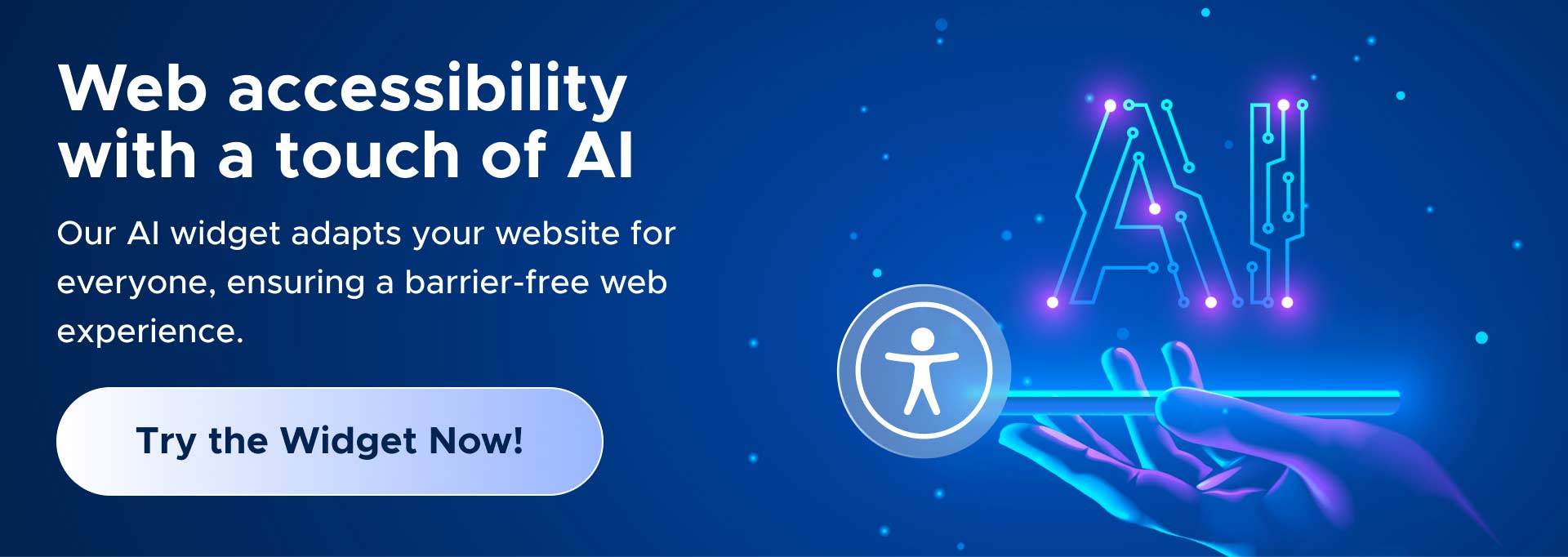Advancing inclusivity through assistive technology

Diversity is a fundamental truth for all human beings. Our abilities, strengths, and challenges vary widely, shaping how we interact with the world. People with disabilities face unique obstacles in their daily lives, but the evolution of technological aids such as assistive technology marks a new era of empowerment and inclusion.
This blog explores the transformative role of assistive technology for people with disabilities. We examine how it makes communication more equitable, leads to greater independence, and provides more opportunities for an inclusive society.
Let’s start with a basic definition.
What is assistive technology?
Assistive technologies cover numerous tools, devices, and systems that help eliminate barriers for people with disabilities. From wheelchairs and prosthetics to screen readers and specialized software, these technologies bridge the gap between ability and accessibility. Above all else, they provide much-needed independence by improving quality of life and promoting equal opportunity.
Typically, the accessibility needs of users fall into four areas.
1. Visual: Blind people, those with low vision, and people with color blindness.
2. Auditory: Deaf people and people who are hard of hearing.
3. Motor: People with motor-control limitations, muscle slowness, tremors, and spasms
4. Cognitive: People with learning disabilities, impaired memory, attention challenges, or problem-solving and logic deficiencies.
How does assistive technology improve communication?
Communication poses unique challenges for people with speech or language impairments. Assistive technology and accessibility tools offer diverse solutions, from augmentative and alternative communication (AAC) devices to speech-generating apps and eye-tracking devices and systems. These tools enable users to express their thoughts and emotions and participate actively in person or online.
Assistive technology has also revolutionized access to information and entertainment. Screen readers, speech recognition software, refreshable braille displays, and captioning systems make digital content more accessible. At the same time, text-to-speech and voice recognition software empower users to engage with written materials and navigate digital interfaces independently.
Did You Know?
Did you know that head tracking devices are revolutionizing computer access? These innovative tools allow users to control a computer cursor with just the movement of their head. Particularly beneficial for individuals with limited hand mobility, head tracking technology helps them navigate digital landscapes, play video games, and even drive wheelchairs, enhancing independence and interaction with the world around them.
What are the different types of assistive technology?
1. Screen readers and braille displays
You can adequately code websites for audio or braille translation. This standard assistive technology for reading helps people with vision disabilities or anyone who processes content better through audio.
2. Screen magnifying software
People with low vision use software that magnifies digital screen content.
3. Content tools
People with learning disabilities, attention issues, difficulty with problem-solving and executive functioning, and color blindness can modify text sizes, the space between text lines, and website colors.
4. Voice assistants/voice recognition software
People with restricted fine motor function, slow-acting muscles, or tremors and twitches use speech-to-text assistive technology that converts their speech into digital text. Speech recognition software dictates texts or gives voice commands to your smartphone, opening doors to new ways for everyone to interact with the digital world.
5. Writing and reading assistants
Numerous apps provide assistive technology for people with dyslexia, dysgraphia, or reading and writing disabilities.
6. Cursor-enlarging tools
These accessibility tools significantly expand the standard cursor so the pointer is always visible to people with vision disabilities. They also simplify overall website navigation.
7. Switches and eye trackers
People with fine motor disabilities can use large switch buttons to navigate online. At the same time, non-speaking people who can’t control certain parts of their bodies can use eye-tracking technology to communicate.
8. Closed captioning and transcripts
Deaf people and hard-of-hearing individuals need a video alternative for equal access to content.
What are examples of assistive technology for the visually impaired?
Many assistive technology tools accommodate blind people and those with other vision-related impairments. In addition to screen reading and braille, here are additional ways assistive technology helps this group of end users:
- Dictation software uses standard QWERTY keyboards, but other modified accessories work too.
- Optical Character Recognition (OCR) Systems convert picture images into text that screen readers and braille embossers recognize.
- Video magnifiers or Closed-Circuit Televisions (CCTVs) magnify images onto television screens and other monitors.
- Portable magnifiers are helpful for practical things like reading signs and labels on the go.
- Portable note-takers offer braille or QWERTY input for keyboards and synthesized voice and braille displays for output.
- Portable book readers enable speech-driven access to specially coded files.
- Accessible GPS devices or smartphone apps may offer voice-driven instructions.
As we explore in the next section, assistive technologies also play a big part in education.
Did You Know?
Did you know that assistive listening devices do more than just amplify sound? They are specifically designed to enhance the clarity of speech and cut down background noise, making it easier for individuals with hearing impairments to engage in conversations and enjoy media. From specialized hearing aids to FM systems used in classrooms and theaters, these devices are crucial in bridging the communication gap in noisy environments.
Why is assistive technology in the classroom essential?
Assistive technology in the classroom has a profound and lasting impact. Students with disabilities benefit from a wide range of assistive tools and accommodations. Text-to-speech software, magnification tools, and tactile graphics enable access to textbooks and course materials. Likewise, note-taking apps and organizational tools support academic performance.
Interactive whiteboards, adjustable desks, and specialized software also help encourage participation so every student can thrive. And because individual needs vary, specialized software and devices support students with learning disabilities, such as dyslexia or ADHD.
Assistive technology in education can help personalize learning experiences. By tailoring assistive technology and strategies for students with disabilities, they have an equal playing field to learn and grow.
What about assistive technology in the physical world?
Assistive technology is pivotal for mobility and environmental access. Manual and powered wheelchairs, examples of adaptive technologies, enable users to navigate indoor and outdoor spaces more efficiently. Stairlifts, ramps, and accessible vehicles break down physical barriers and open doors to education, employment, and social engagement.
Beyond physical mobility, technology has revolutionized transportation options. Ride-sharing apps with accessibility features, wheelchair-accessible vehicles, and real-time transit information empower independent travel.
Moreover, assistive devices for the elderly, such as mobility aids and ergonomic tools, promote independence and enhance quality of life, enabling seniors to navigate daily activities more efficiently.
In the workforce, assistive technology enables full participation and productivity for employees with disabilities. Ergonomic workstations, adaptive keyboards, screen-reading software, and speech recognition tools streamline efficiency for everyone. And it’s important to note the remote work opportunities made possible by digital technology. This at-home accessibility is a notable benefit for workers with mobility or transportation challenges.
Assistive technology is an ongoing commitment to inclusivity
Innovation, collaboration and the shared commitment to inclusivity drive the evolution of assistive technology. Engineers, designers, researchers, and people with disabilities collaborate closely to develop solutions that meet diverse needs and preferences.
Open-source platforms and grassroots initiatives encourage innovation and accessibility, driving continuous improvement and refinement. The growing emphasis on universal design principles ensures that products and environments are accessible to people of all abilities.
As we advance technologically and socially, let’s reaffirm our commitment to inclusivity and accessibility, ensuring everyone can participate fully. Empathy, innovation, and collaboration can build a more inclusive and equitable world where everyone is valued, supported, and empowered to thrive.
UserWay makes assistive technology work for you
UserWay’s AI-Powered Accessibility Widget is the right assistive and adaptive technology for any organization. Learn how our complete framework of tools, attorney-led legal support, enterprise solutions, and various partnerships can improve your accessibility and compliance now and in the future.
Take the first step to better accessibility.
Answers to Common FAQs
How does assistive technology help people with disabilities?
In the digital world, it helps them use and benefit from websites, apps, and devices equally.
How does assistive technology affect learning?
It empowers students with disabilities to access the necessary resources that help them succeed.
How many people need assistive technology?
Roughly 20 percent of the population (over 6 million in the U.S. alone) rely on assistive technology.
How do I prepare for incorporating assistive technology services?
Start by using all resources at your disposal to meet WCAG compliance. American lawyers, web admins, and the Department of Justice (DOJ) increasingly rely on the WCAG, particularly concerning ADA compliance. Meeting these standards will make your site more digitally accessible, prevent unnecessary lawsuits, and help boost your eCommerce sales.
How Do I Formulate a Digital Accessibility Plan?
Assistive technology is an integral part of many disabled people’s lives. According to the WHO, 2 billion people will use it by 2030. This makes a digital accessibility plan both a legal and a moral imperative today.
Here are some tips for getting started:
- Learn about WCAG accessibility standards
- Garner collective support from key leaders and staff members
- Provide the latest technology tools to appropriate personnel
- Partner with a reputable third-party provider
- Lean on disability expertise and organizations
- Plan for and embed accessibility into your organization





Share